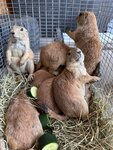



FORT WORTH — In a significant local conservation initiative, the Fort Worth Nature Center & Refuge, in collaboration with the Friends of the Fort Worth Nature Center, has relocated a new colony of black-tailed prairie dogs to its grounds. This effort marks a hopeful, yet cautious, step forward, following the loss of the FWNC&R’s previous prairie dog colony in 2015, likely due to disease — a fate that unfortunately has become common across their range habitats.
The sylvatic plague, a flea-born bacterial disease, became a significant problem for prairie dog populations after it was introduced to the United States by rats arriving on ships at the turn of the 20th century. As much as 90% or more of a prairie dog colony is likely to die off after infection from this disease, according to the United States Geological Survey.
FWNC&R natural resource staff members Nic Martinez and David Reasoner, along with Friends board member Megan McConnell, recently traveled to Canyon to capture and transport the prairie dogs to their new home in Fort Worth. The relocation was necessitated by the impending construction of a housing development on the prairie dogs' original colony.
Prairie dogs, as a keystone species, play an essential role in maintaining the health of prairie ecosystems; their presence also offers valuable educational opportunities for the public. A wide variety of native fauna are reliant on prairie dog burrows, and prairie dogs themselves, for their survival.
“Translocations are inherently challenging and typically are a last-resort measure in wildlife management, but we are fully committed to providing this colony with the best possible conditions for establishing a new home here,” said FWNC&R Acting Manager Jared Wood. “The threat of disease, which has decimated many prairie dog populations across their range, always remains a concern. To mitigate this risk, we will use a flea control bait specifically designed to prevent disease transmission in prairie dog colonies. This preventive measure, which does not harm the prairie dogs, is important in ensuring the long-term health and stability of the newly released animals.”
The collaborative conservation project was made possible through the generous support of Friends board member emeritus Marty Leonard, who remembered fondly the previous colony and how beloved it was by the entire community.
“I was thrilled to be a part of such a great, collaborative effort supporting the establishment of a new prairie dog colony at the Nature Center, especially knowing that we were rescuing these animals from a precarious situation,” Leonard said. “It’s incredibly rewarding to see them safe and thriving thus far in their new Fort Worth home.”
Leonard was honored by the FWNC&R in April with the opening of the Marty Leonard Lotus Marsh Boardwalk on the far northwest side of the property. From this viewing platform, visitors can get an up-close look at some of the wildlife that calls the waters and marshes of Lake Worth their home. On Fridays from 8 – 9 a.m., visitors can even enjoy a yoga class on the boardwalk for $5 after admission to the park.
Upon arrival, the prairie dogs were released using specially designed traps that open into artificial burrows, which were constructed by FWNC&R staff and volunteers. These initial burrows offer crucial shelter and protection from predators as the prairie dogs begin the process of digging and establishing their burrow system. During this critical acclimation period, FWNC&R staff are providing daily food to support the colony’s transition to its new environment. Prairie dogs primarily get their water from food sources, so the staff are carefully selecting and providing a diet that ensures the colony receives adequate hydration.
“Working with the prairie dogs has been an enjoyable experience for my team,” added Wood. “While we are optimistic the colony will succeed, we recognize the uncertainties in relocating wildlife. The reestablishment of prairie dogs at the Nature Center not only will enrich our pastures but also serve as an invaluable educational resource for our visitors.”